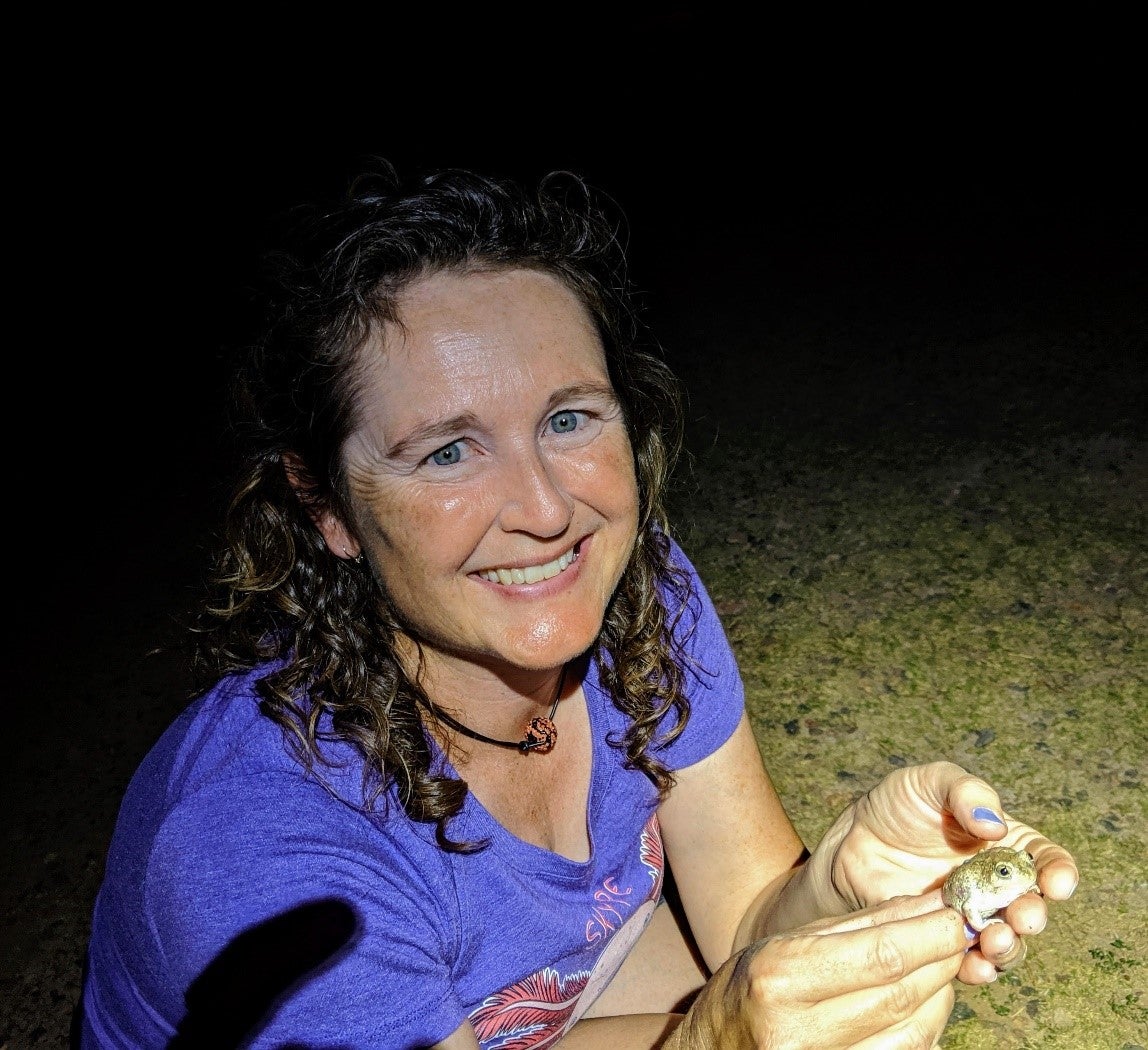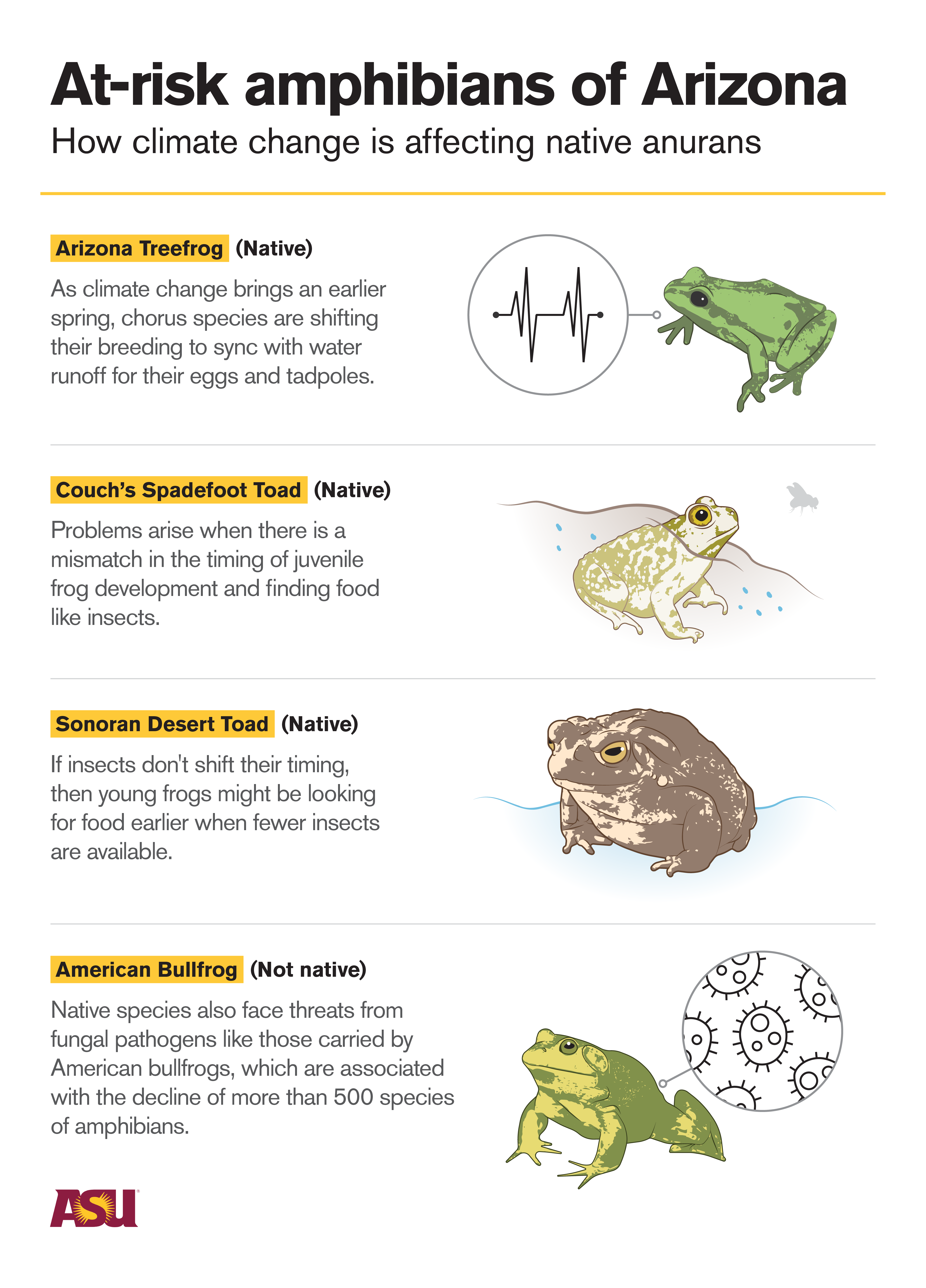It ain’t any easier being green.
March 20 marks World Frog Day, an annual observance of the tailless amphibian. It was created in 2012 with the intention to save many different species of frogs from going extinct. In the past decade, approximately 170 species of frogs have vanished due to human activity and fungal infections.
You might not personally care for these the croakers (who are also predators), but they play a crucial role in maintaining the environment. No one knows this better than Heather Bateman, an associate professor with Arizona State University’s College of Integrative Arts and Sciences.
ASU Now spoke to Bateman, a field ecologist who studies terrestrial wildlife such as birds, reptiles and amphibians, about why frogs are important to our ecosystem.
Heather Bateman with a Mexican spadefoot toad (Spea multiplicata).
Question: How many native frogs and toads are there in Arizona, and can you tell me some fun facts about a few of them?
Answer: We live in the Sonoran Desert, and Arizona has 27 species of frogs and toads called “anurans.” That might surprise some people, but we have some species with unique adaptations for living in such an arid environment. The term "toad" tends to refer to more terrestrial anurans with warty skin and without webbed feet. But if we want to be biologically accurate about classification, only true toads are in the family Bufonidae.
In addition to true toads, Arizona is home to treefrogs, true frogs or water frogs, and spadefoot toads. Spadefoot toads are really interesting and have adaptations that allow them to live in deserts or arid places. These anurans are named for a small, black tubercle on their hind feet. Spadefoots spend most of their adult life in burrows underground. They dig with the "spade" on their hindlimbs and move below the surface backwards. Their unique adaptations to living in the desert are exemplified in their reproductive life history. Spadefoots are in burrows underground and they come to the surface during summer monsoon rains. One idea is that spadefoots can detect the vibration (low frequency sound) caused by strong rains as a cue to move to the surface. They seek rain-filled pools of water that form on the surface, generally avoiding permanent bodies of water like a lake or river. Males give advertisement calls after these heavy rains to find mates.
Like most anurans, spadefoots lay their eggs in water, eggs hatch into tadpoles, tadpoles metamorphose into frogs. The eggs are fertilized in the small pools and the adults retreat back underground. The remarkable thing is how quickly eggs hatch into tadpoles — a matter of hours, 36 hours for some species — and then tadpoles can metamorphose in a matter of a week or so. This is critical for an aridland species, those little toadlets need to leave the pools before they evaporate. I think spadefoots, like the Couch’s spadefoot, are one of my favorite anurans. They can be common in some urban areas and they have lovely green eyes.
Q: Let’s talk specifically about the Sonoran Desert toad, considered the largest in the U.S.
A: Oh yes, the Sonoran Desert toad – who doesn't love a football-sized amphibian?! This is another species tied to summer monsoon rains. This toad has glandular skin that can secrete toxins, called bufotoxins. These toxins can be very dangerous to mammal predators and can be strong enough to kill a dog. Some of the toxins may have hallucinogenic qualities. People should not be fearful of the toads; they can be moved easily by wearing gloves. They are really impressive anurans for sure.
Infographic by Alex Davis/ASU Now
Q: What are frogs’ main function in the ecological system and what are some things they do that most people might not be aware of?
A: Frogs and other amphibians are important components of a food web. Because they are ectothermic and maintain body temperatures close to environmental temperatures, they are efficient at converting the food they eat into more frogs — think growth and reproduction, instead of maintaining high body temperatures like birds and mammals. In some ecosystems, amphibian biomass is so great it might exceed the squirrels or birds in a forest. Ecosystems with ectotherms, like frogs, can support higher trophicThe trophic level of an organism is the position it occupies in a food web. levels like birds of prey and mammal carnivores.
We have one species of frog in Arizona that is nonnative and is a conservation concern. The American bullfrog is from the southeastern U.S. and is considered introduced in Arizona. The bullfrog is actually the largest anuran in North America and eats anything it can fit into its mouth. The bullfrog is a conservation concern because it can (prey on) native species that might be naive to this predator. Bullfrogs can eat other frogs, turtles, baby birds. … Bullfrogs can also carry fungal pathogens and be harmful to other frogs. Bullfrogs have some resistance to this fungal pathogen — Batrachochytrium dendrobatidis or Bd — but Bd can be deadly for other frogs. The fungus causes a disease called Chytridiomycosis and is one of the most threatening wildlife diseases in the world. It is estimated that Bd has been responsible for the decline of over 500 species of amphibians.
Q: Since Earth Day is approaching, is there any evidence of climate change changing behaviors or damaging these species?
A: Some species of chorus frogs in other regions breed very early in the spring. As climate change shortens the winter season in these locations, spring comes earlier. Some frogs are shifting their timing of when to breed so they are in sync with spring runoff and water is available for eggs and tadpoles. This might be fine, but problems arise when there is a mismatch for the timing of tadpole development or juvenile frogs and finding food like insects. If insects don't shift their timing, then young frogs might be looking for food earlier with fewer insects available. Researchers call the timing of life events — such as reproduction or migration — “phenology.” There are entire teams of researchers who study phenology of plants and animals and how climate change could affect species differently.
Q: Where can we learn more about the subject?
A: If people want to learn more about Arizona frogs and toads, they should visit www.reptilesofaz.org/amphibians.html. This site has the species and a description of their calls. Because male frogs will call to attract mates, each species has a very unique call — just like bird songs. In my class, students learn some of the calls of common frogs and it's so much fun to hear them in the summer at night calling.
Top photo courtesy of Pixabay.
More Science and technology

ASU and Deca Technologies selected to lead $100M SHIELD USA project to strengthen U.S. semiconductor packaging capabilities
The National Institute of Standards and Technology — part of the U.S. Department of Commerce — announced today that it plans to award as much as $100 million to Arizona State University and Deca…

From food crops to cancer clinics: Lessons in extermination resistance
Just as crop-devouring insects evolve to resist pesticides, cancer cells can increase their lethality by developing resistance to treatment. In fact, most deaths from cancer are caused by the…

ASU professor wins NIH Director’s New Innovator Award for research linking gene function to brain structure
Life experiences alter us in many ways, including how we act and our mental and physical health. What we go through can even change how our genes work, how the instructions coded into our DNA are…


